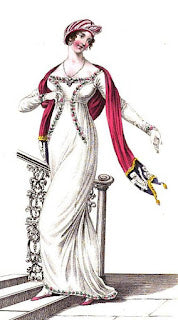
Step back in time to the early 19th century, a period known for its social and cultural transformation – the British Regency Era spans from 1800 to 1825, this captivating epoch marked the regency of George, Prince of Wales, and witnessed an extravagant evolution in fashion. From the stunning gowns to the dapper suits, Regency fashion was a reflection of elegance and refinement, with a distinct departure from the elaborate styles of the previous Georgian era. In this blog, we explore the highlights of Regency fashion, its influences, and its impact on the way people dressed during these remarkable 25 years.
The early 19th-century styles are recognized under distinct names, varying depending on the country being referred to:
- Regency (England, 1811-1820)
- Federal (United States, 1785-1815)
- Napoleonic (France, 1799-1815)
- The Shift from Georgian to Regency Fashion
As the 18th century drew to a close, there was a shift towards more simple and classical influences in fashion. The Georgian era's ornate and heavily embellished styles gave way to a more restrained and graceful aesthetic. Regency fashion embraced high waistlines, lightweight fabrics, and empire silhouettes, inspired by ancient Greek and Roman dress. The desire to imitate classical ideals in clothing represented a cultural fascination with the art and culture of antiquity.
- Women's Fashion: Graceful Elegance Personified
Regency women's fashion was all about grace and poise. The iconic empire waistline became the hallmark of their gowns, accentuating the natural waist just below the bust. Dresses were often made of light muslin or silk, flowing effortlessly to the floor. The simplicity of the garments allowed for the use of intricate embroidery, delicate lace, and subtle floral patterns.
Accessories played a pivotal role in enhancing the Regency look. Large-brimmed bonnets adorned with feathers and ribbons shielded women from the sun while also adding an air of sophistication to their ensemble. Gloves, parasols, and shawls were other essential accessories that completed their fashionable appearance.
- Men's Fashion: Dapper and Refined
Regency fashion for men epitomized a sense of refinement and elegance. Tailored suits with narrow-cut trousers, waistcoats, and tailored coats became the norm. The emphasis on well-fitted attire highlighted the masculine figure, setting aside the overly loose and flamboyant styles of the previous era.
Linen shirts with cravats or neckcloths tied in intricate knots were worn with pride, signifying a gentleman's sartorial prowess. Top hats and leather boots completed the look, making men stand out with their timeless sophistication.
- Influential Figures: Beau Brummell and Jane Austen
No discussion of Regency fashion would be complete without mentioning the influential figures who left an indelible mark on the era's clothing trends.
George Bryan "Beau" Brummell was a prominent arbiter of men's fashion during the Regency period. He popularized the perfectly tailored and understated look, advocating for immaculate cleanliness and elegant simplicity. His influence on Regency fashion extended beyond just clothing, as he laid the foundation for modern men's fashion that continues to be admired today.
Jane Austen, the renowned English novelist, also played a significant role in shaping Regency fashion through her literary works. Her descriptions of characters' attire in novels like "Pride and Prejudice" and "Sense and Sensibility" provided invaluable insights into the clothing choices of the time.
- The Legacy of Regency Fashion
Regency fashion's impact extended far beyond the early 19th century, leaving an everlasting impression on modern styles. Elements such as the empire waistline, high collars, and elegant simplicity continue to influence contemporary fashion designers. Period dramas and movies set in the Regency era have also rekindled interest in this timeless and graceful style.
Conclusion
The Regency Era was a transformative period in fashion history, characterized by the rise of elegant simplicity and classical influences. Women's gowns exuded grace, while men's attire oozed refinement. Influential figures like Beau Brummell and Jane Austen played instrumental roles in shaping the Regency fashion legacy, which lives on today in various forms.
As we marvel at the sheer elegance of Regency fashion, let us remember that clothing is not merely about appearances; it is an expression of cultural values and societal changes. The Regency Era's fashion continues to inspire us, reminding us of the enduring allure of an era that personified elegance and refinement like no other.
